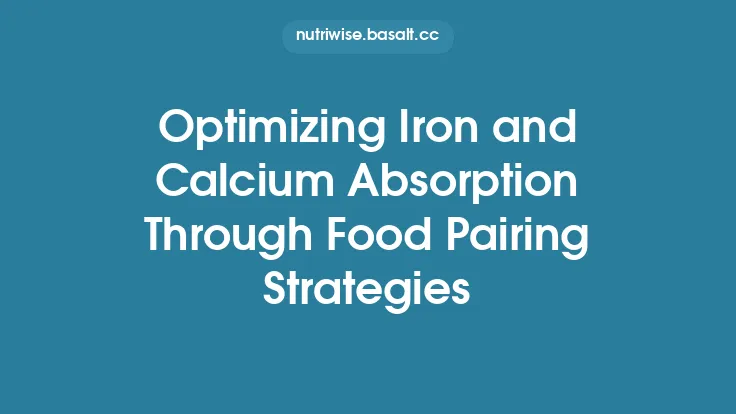Calcium is the most abundant mineral in the human body, and its successful incorporation into bone tissue hinges not only on how much is consumed but also on how efficiently the gastrointestinal tract can absorb it. While many readers are familiar with the basic need for calcium, the nuances of its uptake are often overlooked. Understanding the physiological mechanisms, the dietary and lifestyle factors that can either promote or hinder absorption, and the ways to tailor everyday habits for optimal uptake can empower anyone to maintain strong, healthy bones over a lifetime.
Physiological Pathways of Calcium Absorption
Calcium absorption occurs primarily in the small intestine, with the duodenum and proximal jejunum accounting for the bulk of uptake. Two distinct mechanisms operate simultaneously:
- Active, Vitamin‑D‑Dependent Transport
- Location: Predominantly the duodenum.
- Process: 1,25‑dihydroxyvitamin D (calcitriol) binds to nuclear receptors in enterocytes, up‑regulating the expression of calcium‑binding proteins such as calbindin‑D9k and calcium channels (TRPV6). These proteins facilitate the transcellular movement of calcium from the lumen, across the cell, and into the bloodstream.
- Regulation: Parathyroid hormone (PTH) stimulates renal 1α‑hydroxylase, increasing calcitriol synthesis when serum calcium falls, thereby enhancing active transport.
- Passive, Paracellular Diffusion
- Location: Throughout the small intestine, especially the jejunum and ileum.
- Process: When luminal calcium concentrations are high, calcium can slip between enterocytes through tight junctions driven by electrochemical gradients. This route does not require vitamin D but is limited by the concentration gradient and intestinal permeability.
Both pathways are essential; the active route dominates at low dietary calcium intakes, while the passive route becomes more relevant when calcium intake is abundant.
Key Nutrients That Enhance Calcium Uptake
Vitamin D (Calcitriol)
Although the focus of a separate guide is the broader relationship between calcium and vitamin D, it is worth noting that adequate vitamin D status is a prerequisite for the active transport mechanism. Even modest increases in serum 25‑hydroxyvitamin D (from 20 ng/mL to 30 ng/mL) can raise intestinal calcium absorption efficiency by 20–30 %.
Magnesium
Magnesium acts as a co‑factor for enzymes involved in vitamin D metabolism and stabilizes the conformation of calcium‑binding proteins. Deficiency impairs the synthesis of calcitriol and reduces calbindin expression, leading to a measurable drop in absorption efficiency (approximately 5–10 % in controlled studies).
Phosphorus (in Balanced Ratios)
Phosphorus is a structural partner of calcium in hydroxyapatite crystals. When dietary calcium and phosphorus are consumed in a ratio close to 1:1, the intestinal environment favors the formation of soluble calcium‑phosphate complexes that are more readily absorbed. Excessive phosphorus without adequate calcium can precipitate calcium as insoluble salts, reducing bioavailability.
Lactose and Certain Amino Acids
Lactose, the primary sugar in milk, can enhance calcium absorption by forming soluble calcium‑lactose complexes that remain in solution at intestinal pH. Similarly, specific amino acids (e.g., lysine, arginine) and small peptides can chelate calcium, facilitating its transport across the enterocyte membrane.
Prebiotic Fibers
Inulin‑type fructans and galactooligosaccharides (GOS) are fermented by colonic bacteria, producing short‑chain fatty acids (SCFAs) that lower colonic pH. A more acidic environment increases calcium solubility, allowing a modest portion of calcium to be absorbed in the large intestine via passive diffusion.
Dietary Components That Impede Calcium Absorption
Oxalates
Found in foods such as spinach, rhubarb, beet greens, and certain nuts, oxalate ions bind calcium to form calcium oxalate crystals, an insoluble compound that passes through the gut unabsorbed. High‑oxalate meals can reduce calcium absorption by up to 30 % when consumed concurrently with calcium‑rich foods.
Phytates (Phytic Acid)
Whole grains, legumes, seeds, and nuts contain phytic acid, which chelates calcium (and other minerals) into insoluble phytate complexes. Traditional preparation methods—soaking, sprouting, fermenting, or using sourdough fermentation—hydrolyze phytate, markedly improving calcium bioavailability.
Excess Sodium
High dietary sodium (≥ 2 g/day) increases urinary calcium excretion, indirectly lowering net calcium balance. Moreover, sodium can compete with calcium for transporters in the renal tubules, exacerbating calcium loss.
Caffeine and Certain Polyphenols
Caffeine (≈ 200 mg) can increase urinary calcium excretion by 5–6 % and modestly reduce intestinal absorption. Similarly, high concentrations of tannins (in strong tea or coffee) can bind calcium, though typical consumption levels have a relatively minor effect.
Alcohol
Chronic heavy alcohol intake impairs vitamin D activation, damages the intestinal mucosa, and increases urinary calcium loss, collectively diminishing net calcium absorption.
Medications
- Proton Pump Inhibitors (PPIs) & H2 Blockers: By reducing gastric acidity, these drugs decrease the solubilization of calcium salts, especially calcium carbonate, which requires an acidic environment for optimal dissolution.
- Loop and Thiazide Diuretics: Loop diuretics increase calcium excretion, while thiazides reduce it; however, both can affect overall calcium balance.
- Glucocorticoids: Long‑term glucocorticoid therapy suppresses intestinal calcium absorption and enhances renal calcium loss.
Influence of Gastrointestinal Health and Microbiota
A healthy, intact mucosal surface is essential for active calcium transport. Conditions that compromise the intestinal lining—celiac disease, inflammatory bowel disease (IBD), short‑bowel syndrome, or chronic diarrhea—significantly reduce absorption efficiency, sometimes by more than 50 %.
Emerging research highlights the role of the gut microbiome in mineral metabolism. Certain bacterial strains (e.g., *Lactobacillus reuteri, Bifidobacterium longum*) produce metabolites that increase calcium solubility and stimulate expression of calcium‑binding proteins. Conversely, dysbiosis can diminish these beneficial effects, underscoring the importance of a diverse, fiber‑rich diet for maintaining a microbiome conducive to calcium uptake.
Impact of Age, Hormones, and Genetic Variability
- Age: With advancing age, gastric acid production declines (hypochlorhydria), reducing the dissolution of calcium carbonate. Additionally, the expression of active transport proteins wanes, shifting reliance toward passive diffusion, which is less efficient at low intakes.
- Hormonal Status: Estrogen up‑regulates calcium‑binding proteins; post‑menopausal estrogen decline contributes to reduced absorption. Conversely, PTH spikes in response to low serum calcium, temporarily enhancing active transport but also promoting bone resorption if sustained.
- Genetics: Polymorphisms in the *TRPV6 channel gene, the vitamin D receptor (VDR), and the CALB1* (calbindin) gene have been linked to inter‑individual differences in calcium absorption efficiency, explaining why some people maintain bone health on modest calcium intakes while others require higher amounts.
Practical Strategies to Optimize Calcium Absorption
- Pair Calcium‑Rich Foods with Enhancers
- Combine dairy or fortified plant milks with a source of vitamin D (e.g., sunlight exposure or modest supplementation).
- Include a modest amount of lactose‑containing foods (milk, yogurt) or whey protein to boost absorption.
- Mitigate Inhibitors Through Food Preparation
- Soak, sprout, or ferment beans, lentils, and whole grains to reduce phytate content.
- Boil or steam high‑oxalate greens and discard the cooking water to leach out soluble oxalates.
- Choose Calcium Salts Wisely
- Calcium citrate dissolves readily at neutral pH and is less dependent on gastric acid, making it a preferable choice for older adults or those on acid‑suppressing medication.
- Calcium carbonate, while cost‑effective, should be taken with meals to ensure adequate stomach acidity for dissolution.
- Space Inhibitory Substances
- Consume coffee, tea, or high‑sodium meals at least 1–2 hours apart from calcium‑dense foods to minimize competitive binding.
- Support Gut Health
- Incorporate prebiotic fibers (e.g., chicory root, garlic, onions) and probiotic‑rich foods (yogurt, kefir, fermented vegetables) to foster a microbiome that favors calcium solubility.
- Monitor Medication Interactions
- If long‑term PPI use is necessary, consider calcium citrate or a calcium‑vitamin D supplement taken with meals to offset reduced acid‑mediated dissolution.
- Lifestyle Considerations
- Maintain regular weight‑bearing exercise, which not only stimulates bone formation but also improves intestinal motility, indirectly supporting nutrient absorption.
Common Misconceptions About Calcium Absorption
- “More Calcium Always Means Better Bone Health.”
Excessive calcium intake (> 2,500 mg/day for most adults) does not proportionally increase absorption; the body regulates uptake, and surplus calcium may be excreted or deposited in soft tissues.
- “All Calcium Supplements Are Equivalent.”
As noted, calcium citrate and calcium carbonate differ markedly in their dependence on gastric acidity. Selecting the appropriate form based on individual gastrointestinal conditions is crucial.
- “Vitamin D Is Only Needed for Bone Health.”
While vitamin D’s role in calcium absorption is central, it also influences immune function and muscle performance, which indirectly affect fall risk and bone integrity.
- “Plant‑Based Calcium Is Inferior.”
The bioavailability of calcium from fortified plant milks, tofu set with calcium salts, and certain leafy greens (e.g., kale, bok choy) can be comparable to dairy when inhibitors are managed.
By appreciating the intricate balance of enhancers and inhibitors, recognizing the physiological pathways that govern calcium uptake, and applying evidence‑based dietary and lifestyle practices, individuals can maximize the fraction of ingested calcium that truly reaches the bloodstream—and ultimately, the bone matrix. This nuanced approach transcends simple “calcium‑counting” and equips readers with the tools needed for lifelong skeletal resilience.





